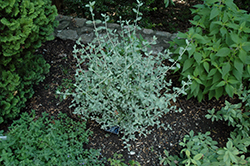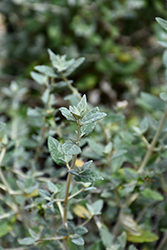It's all about ...
plants

Height: 4 feet
Spread: 6 feet
Sunlight:
![]()
![]()
Hardiness Zone: 8a
Other Names: Shrubby Germander, Tree Germander
Description:
A very easy to grow, shrubby variety, producing striking branches of pale blue leaves with silvery undersides; pale blue flowers are subtle but still interesting; a beautiful, textural plant that is drought tolerant and low maintenance
Ornamental Features
Bush Germander has attractive powder blue foliage with silver undersides which emerges white in spring on a plant with a mounded habit of growth. The oval leaves are highly ornamental and remain powder blue throughout the winter. It features subtle spikes of sky blue flowers rising above the foliage in mid spring.
Landscape Attributes
Bush Germander is a multi-stemmed evergreen shrub with a mounded form. Its relatively fine texture sets it apart from other landscape plants with less refined foliage.
This is a relatively low maintenance shrub, and is best pruned in late winter once the threat of extreme cold has passed. Deer don't particularly care for this plant and will usually leave it alone in favor of tastier treats. It has no significant negative characteristics.
Bush Germander is recommended for the following landscape applications;
- Mass Planting
- Rock/Alpine Gardens
- General Garden Use
- Herb Gardens
Planting & Growing
Bush Germander will grow to be about 4 feet tall at maturity, with a spread of 6 feet. It tends to fill out right to the ground and therefore doesn't necessarily require facer plants in front. It grows at a fast rate, and under ideal conditions can be expected to live for approximately 10 years.
This shrub does best in full sun to partial shade. It is very adaptable to both dry and moist locations, and should do just fine under average home landscape conditions. It is considered to be drought-tolerant, and thus makes an ideal choice for xeriscaping or the moisture-conserving landscape. It is not particular as to soil type or pH. It is somewhat tolerant of urban pollution. Consider applying a thick mulch around the root zone in winter to protect it in exposed locations or colder microclimates. This species is not originally from North America. It can be propagated by division.
This plant is not reliably hardy in our region, and certain restrictions may apply; contact the store for more information.

